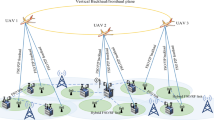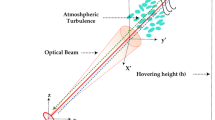Abstract
The increasing availability of unmanned aerial vehicles (UAVs) is an exciting part of future emerging technology with advanced scientific and industrial interests. Free space optical (FSO) communications’ ability to offer very high data rates and the mobility of unmanned aerial vehicle (UAV) flying platforms make the delivery of Fifth-Generation (5G) wireless networking services appealing to FSO-UAV-based solutions. UAVs play a greater role in end-to-end delivery in next- generation wireless networking systems, serving as a base station, capacity enhancement, high data access, and other disaster management systems. To establish a link between unmanned aerial vehicles and ground stations, FSO can be applied. But, the different weather conditions liken rain, fog effects on the performance of the FSO link, contributing to the loss of the signal. In this paper, we proposed polarization shift keying (POLSK) modulated FSO link based UAV–UAV communication system for 6G beyond applications. We examine the effect of different weather conditions such as rain, fog on the bit error rate (BER) performance of the proposed system. Novel closed-form expressions for UAV–UAV based FSO propagation channel are derived, and BER performance is investigated under different weather conditions. Fog and rain are the main limiting factors mitigated in this paper by suitable mitigation techniques by increasing receiver field of view.









Similar content being viewed by others
References
Adamchik, V.S., Marichev, O.I.: The algorithm for calculating integrals of hypergeometric type functions and its realization in REDUCE system. In: Proceedings of the International Symposium on Symbolic and Algebraic Computation (1990)
Alzenad, M., et al.: FSO-based vertical backhaul/fronthaul framework for 5G+ wireless networks. IEEE Commun. Mag. 56(1), 218–224 (2018)
Awan, M. S., et al.: Cloud attenuations for free-space optical links. In: 2009 International Workshop on Satellite and Space Communications, pp. 274–278. IEEE (2009)
Chlestil, C., et al.: Reliable optical wireless links within UAV swarms. In: 2006 international conference on transparent optical networks, vol. 4, pp. 39–42. IEEE (2006)
Dabiri, M.T., Rezaee, M., Shafique Ansari, I., Yazdanian, V.: Channel modeling for UAV-based optical wireless links with nonzero boresight pointing errors. IEEE Trans. Veh. Technol. 69(12), 14238–14246 (2020)
Dabiri, M.T., Sadough, S.M.: Optimal placement of UAV-assisted free-space optical communication systems with DF relaying. IEEE Commun. Lett. 24(1), 155–158 (2019)
Dabiri, M.T., Sadough, S.M., Khalighi, M.A.: Channel modeling and parameter optimization for hovering UAV-based free-space optical links. IEEE J. Select. Areas Commun. 36(9), 2104–2113 (2018)
Farid, A.A., Hranilovic, S.: Outage capacity optimization for free-space optical links with pointing errors. J. Lightw. Technol. 25(7), 1702–1710 (2007)
Ghassemlooy, Z., Popoola, W., Rajbhandari, S.: Optical Wireless Communications: System and Channel Modelling with Matlab\(\textregistered\). CRC Press (2019)
Grabner, M., Kvicera, V. Fog attenuation dependence on atmospheric visibility at two wavelengths for FSO link planning. In: 2010 Loughborough Antennas & Propagation Conference, pp. 193–196. IEEE (2010)
Harris, A., et al.: Free-space optical wavelength diversity scheme for fog mitigation in a ground-to-unmanned-aerial-vehicle communications link. Opt. Eng. 45(8), 086001 (2006)
Jung, K.-J., et al.: Unified finite series approximation of FSO performance over strong turbulence combined with various pointing error conditions. IEEE Trans. Commun. 68(10), 6413–6425 (2020)
Kaadan, A., Refai, H.H., LoPresti, P.G.: Multielement FSO transceivers alignment for inter-UAV communications. J. Lightw. Technol. 32(24), 4785–4795 (2014)
Kaushal, H., Kaddoum, G.: Optical communication in space: challenges and mitigation techniques. IEEE Commun. Surv. Tutor. 19(1), 57–96 (2016)
Kaymak, Y., et al.: A survey on acquisition, tracking, and pointing mechanisms for mobile free-space optical communications. IEEE Commun. Surv. Tutor. 20(2), 1104–1123 (2018)
Khuwaja, A.A., et al.: A survey of channel modeling for UAV communications. IEEE Commun. Surv. Tutor. 20(4), 2804–2821 (2018)
Kong, H., et al.: Multiuser scheduling for asymmetric FSO/RF links in satellite-UAV-terrestrial networks. IEEE Wirel. Commun. Lett. 9(8), 1235–1239 (2020)
Krishnan, P., Kumar, D.S.: Performance analysis of free-space optical systems employing binary polarization shift keying signaling over gamma-gamma channel with pointing errors. Opt. Eng. 53(7), 076105 (2014)
Lee, J.-H., et al.: Throughput maximization of mixed FSO/RF UAV-aided mobile relaying with a buffer. IEEE Trans. Wirel. Commun. 20(1), 683-694 (2020)
Najafi, M., et al.: Statistical modeling of FSO fronthaul channel for drone-based networks. In: 2018 IEEE International Conference on Communications (ICC), pp. 1–7. IEEE (2018)
Nallagonda, V.R., Krishnan, P.: Performance analysis of FSO based inter-UAV communication systems. Opt. Quantum Electron. 53(4), 1–20 (2021)
Ortiz, G. G., Lee, S., Monacos, S.P., et al.: Design and development of a robust atp subsystem for the altair 217 uav-to-ground lasercomm 2.5-gbps demonstration. In: Free-Space Laser Communication Technologies XV, 218 4975, pp. 103–114. International Society for Optics and Photonics (2003)
Pati, S., Preeti, K., Prabu.: Modelling of OFDM based RoFSO system for 5G applications over varying weather conditions: a case study. Optik 184 (2019): 313–323
Prabu, K., Cheepalli, S., Kumar, D.S.: Analysis of PolSK based FSO system using wavelength and time diversity over strong atmospheric turbulence with pointing errors. Opt. Commun. 324, 318–323 (2014)
Prabu, K., Gupta, S., Jaiswal, S.: Impact of pointing errors and turbulence effects on POLSK and coherent OWC-based FSO system over generalized turbulence channel model. Photonic Netw. Commun. 36(1), 96–105 (2018)
Rajeev, M., Mathew, Geethu A., Krishnan, P.: Analysis of beam divergence on free space optical link using polarization shift keying technique. Opt. Eng. 58(4), 046109 (2019)
Sandalidis, H.G., Tsiftsis, T.A., Karagiannidis, G.K.: Optical wireless communications with heterodyne detection over turbulence channels with pointing errors. J. Lightw. Technol. 27(20), 4440–4445 (2009)
Swamidoss, I, et al.: Average spectral efficiency analysis of FSO communication link over atmospheric turbulence channel using various modulation techniques for UAV application. In Environmental Effects on Light Propagation and Adaptive Systems II, vol. 11153. International Society for Optics and Photonics (2019)
Tsiftsis, T.A.: Performance of heterodyne wireless optical communication systems over gamma-gamma atmospheric turbulence channels. Electron. Lett. 44(5), 372–373 (2008)
Weisstein, E.W.: Mathworld–a wolfram web resource (2004)
Yang, F., Cheng, J., Tsiftsis, T.A.: Free-space optical communication with nonzero boresight pointing errors. IEEE Trans. Commun. 62(2), 713–725 (2014)
Author information
Authors and Affiliations
Corresponding author
Additional information
Publisher's Note
Springer Nature remains neutral with regard to jurisdictional claims in published maps and institutional affiliations.
Rights and permissions
About this article
Cite this article
Nallagonda, V.R., Krishnan, P. Bit error rate analysis of polarization shift keying based free space optical link over different weather conditions for inter unmanned aerial vehicles communications. Opt Quant Electron 53, 538 (2021). https://doi.org/10.1007/s11082-021-03188-0
Received:
Accepted:
Published:
DOI: https://doi.org/10.1007/s11082-021-03188-0




